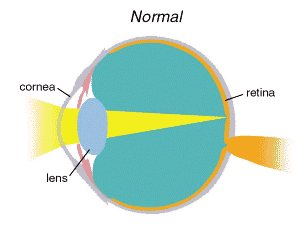|
Light passes through the cornea-the curved, clear front surface of the eye. It then passes through the pupil and the lens. The curved surface of the cornea and the lens inside the eye bend the light rays so that images of distant objects are focused on the retina, the layer of nerve cells in the back of the eye. Rays of light from near objects must be bent more than rays of light from distant objects to focus them sharply on the retina. Therefore, the lens inside the eye must change its shape to maintain a sharp image when looking from distant to near objects. The lens becomes somewhat rigid with age, which is why most older people need reading glasses or bifocals to read.
 |
 |
|
In the normally functioning eye, light passes through the lens and forms a sharp image on the retina. (Photo and illustration courtesy NEI)
|
|
|
|